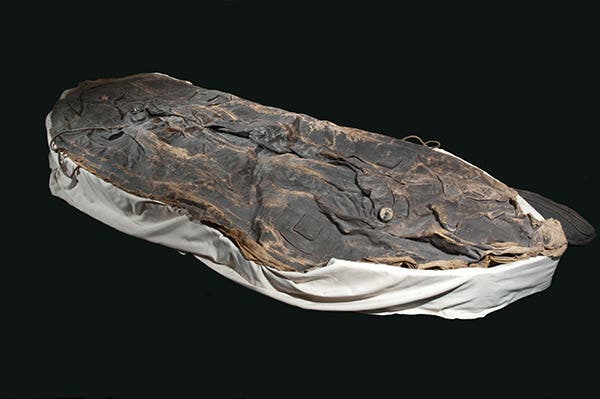Scientist of the Day - Peter Halkett
Peter Halkett, a British naval officer, was born Oct. 16, 1820. Halkett grew up in the heady decade when attempts were first made to discover a Northwest passage through the Arctic, and the worst disaster occurred during the overland expedition of John Franklin (1819-22), when 11 of the 20 men died because they lost their boats in a storm and were stranded on the wrong side of a river. Halkett joined the Royal Navy and gave considerable thought to designing a lightweight, portable boat that could prevent calamities like the first Franklin expedition disaster.
By 1844, Halkett had invented such a boat. It looked like a large Macintosh cloak, made of rubberized cloth, and could indeed be worn like a cape. But it had four inflatable compartments, and if you blew it up (using a bellows in one of the pockets), you soon had what looked very much like a small lifeboat. For propulsion, you took a small blade from another pocket and screwed it onto your cane to form a paddle, and if the wind was up, you could use a specially designed umbrella for a sail. In 1848, Halkett published a book, Boat-cloak or Cloak-boat, announcing his invention, and containing 6 plates depicting the boat’s design and the boat in operation. We do not own a copy – the only copy known to me is in the Caird Library of the National Maritime Museum at Greenwich, from which we have drawn our images.
Halkett’s boat-cloak sounds like one of those crazy devices, like an automatic hat-tipper, that you see in books on the 100 most bizarre patents, but the explorer John Rae took a Halkett boat on his Arctic expedition of 1846 and praised it to the skies, and he took two more on his 1853 venture that searched for the remains of the final Franklin expedition. The 1853 boats were larger, two-man versions, packed in a box and no longer suitable for wear as a cloak. Halkett had hoped to sell his invention to the Navy, but they were not buying, so very few Halkett boats were actually produced.
Amazingly, two original Halkett rubber boats survive today – both are the larger version. One is in the Manitoba Museum in Canada, still in its wooden box; it once belonged to George Simpson, a governor for the Hudson’s Bay Company, and you can see a photograph here. The other is in the Stromness Museum in the Orkney Islands, and was actually one of the boats taken to Canada by John Rae (third image). If any of the original boat-cloak versions survive, I am unaware of their existence. If any readers know of one in a museum somewhere, we would love to be informed. We would also love to acquire a copy of Halkett's 1848 folio, but the availability of one is, alas, not too likely.
Dr. William B. Ashworth, Jr., Consultant for the History of Science, Linda Hall Library and Associate Professor emeritus, Department of History, University of Missouri-Kansas City. Comments or corrections are welcome; please direct to ashworthw@umkc.edu.








